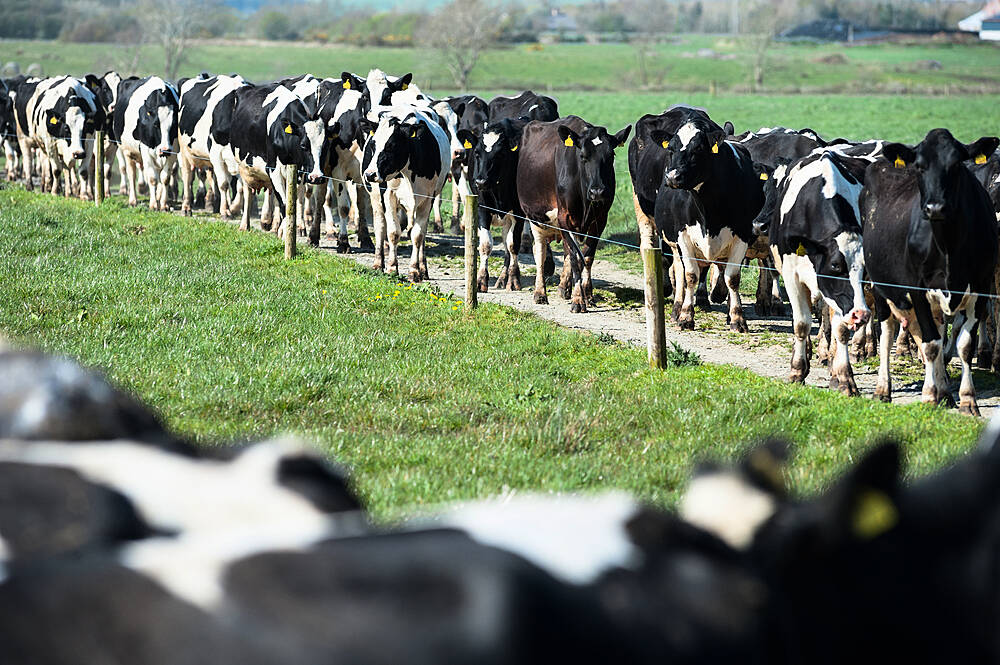Carbery CEO Jason Hawkins and chairman Cormac O’Keeffe know that West Cork farmers are resilient, and will do what is asked of them to secure the future of the sector for the next generation
CARBERY is happy to be able to support this spotlight on sustainability in The Southern Star for West Cork farmers.
Our customers buy our products on the basis of the high standards of quality and sustainability that we are able to demonstrate to them.
And these standards begin on our suppliers’ farms. We are lucky in Ireland to have family farms, raising grass-fed cows, giving us some of the best quality and most sustainably produced milk in the world.
Irish farmers have always farmed with the longevity of their farms and the future in mind, with land handed down between generations. Collectively as a society, we are being asked to modify ways that we do things and habits that we have developed in order to reduce Ireland’s carbon emissions.
There has been disproportionate focus on the role of agriculture in this reduction and fierce debate around the topic. Farming has not been accurately represented or understood by many involved in this debate. However, now the climate targets have been signalled, we have a better idea of what farming needs to achieve by 2030.
The debating can stop and the actions can start. It’s a challenging target no doubt, and climate change as a huge global issue can seem overwhelming. We are still waiting for the full plan for the agriculture sector to emerge.
However, our advantage as farmers and agri-processors is that we know how to begin.
We start, as we always have, with our natural resources – the land, the water, the air – and with reducing the impact on them. We look at opportunities for improving sustainability – new approaches, like lower emission slurry spreading, clover, reducing fertiliser, protected urea, increasing biodiversity.
We consider new technologies, like renewable energy. Whether it is improvements to manage water quality on your farm, advice on switching to protected urea, or changing to lower emission slurry spreading, there is no shortage of guidance available.
We want to point farmers towards the actions they can take that will make the most impact on the collective climate challenge we all need to solve. Irish farmers are resilient.
We have made our way through floods and drought, through Covid and Brexit and kept producing quality food throughout. We will weather our way through this change too, and in the process, create a sustainable and secure future for the next generations of farming in West Cork.
Farming for the future: ways to lower emissions

1. Improve Economic Breeding Index
Economic Breeding Index (EBI) is an efficiency tool to help identify profitable animals. There are a number of ways in which it helps reduce Ireland’s carbon footprint.
Firstly, it helps to improve animal fertility and reduce calving intervals (more calves produced per cow). It delivers higher milk solids yield from grazed, grass, which increases the efficiency of production and decreases emissions per unit of product. There’s also the overall improved health of the herd which leads to higher production levels and lower replacement rates.
Put plainly: research by Teagasc has shown that for each €10 gain in herd EBI there has been a gain of €20 in terms of additional net profit per cow per year and a 3% reduction in the carbon footprint.
2. Extend the grazing season
Ireland’s reputation as having a mainly grass fed system is responsible in no small way for the international demand for both Irish dairy and beef. Keeping our animals on grass for as long as possible is a no-brainer from that perspective, but it also increases efficiencies.
Additional days on grass will reduce the manure generated during housing, which in turn reduces ammonia emissions and greenhouse gases.
According to Teagasc, more grass will reduce ruminant digestion emissions due to a better quality grass diet; there’s lower energy usage and of course, higher milk solids with improved protein content.
Teagasc research has found that a 10-day increase in a farmer’s grazing season can lead to a 1.7% reduction in carbon footprint, and a €27 increase in profit per cow. For every extra day of grazing in the autumn it is worth on average €1.80/cow/day.
3. Use protected urea
Protected urea has been described by Teagasc as the number one technology to reduce greenhouse gas emissions on grassland farms and help achieve ammonia reduction targets identified in the government’s Climate Action Plan. It’s like regular urea (nitrogen fertiliser), but it’s coated with an inhibitor to reduce ammonia emissions. Using protected urea results in a 71% reduction in emissions of the greenhouse gas nitrous oxide.
It can replace both urea and CAN, and Teagasc trials have shown that it consistently and reliably produces top yields under spring and summer growing conditions.
Teagasc also found that protected urea gives a cost saving of 14% compared to CAN. The bottom line: using protected urea will reduce your agricultural greenhouse gas emissions and ammonia emissions while maintaining yield and saving you money.
4. Slurry management
LESS is more when it comes to slurry spreading these days! That’s Low Emission Slurry Spreading technology we’re talking about which has both environmental and practical benefits. Low emissions application technologies such as the trailing shoe or dribble bar leads to reduced NH3, and greenhouse gas losses and increases the fertiliser replacement value of slurry.
Research has shown it can decrease ammonia emissions by up to 30% compared with splash plate application. It also increases the amount of nitrogen available for grass growth by an extra three units for every 1,000 gallons spread, reducing the requirement for chemical nitrogen.
Teagasc says that the extra N alone is worth €5 per 1,000 gallons. LESS also gives increased flexibility, with lower contamination of grass, decreasing grazing return times compared to the splash plate.
All slurry on derogation farms must now be spread using LESS equipment. It’s hoped the country’s LESS usage will get to around 90% by 2027. Regarding storage, with Cork in Zone A, the recommended storage period for livestock manure stands at 16 weeks.
5. Energy efficiency & renewables
Average electricity costs on Irish dairy farms are calculated as €5 per 1,000 litres of milk produced. Primary energy draws are milk cooling (31%); the milking machine itself (20%) and water heating (23%).
It’s possible to cut electricity consumption, and importantly related C02 emissions, by up to 60% and save €2,500 (for a 100 cow herd) through some relatively simple measures. These include a plate cooler as well as a heat recovery system (eg recovery of heat from the cooling system for pre-heating of water).
Variable speed drives on the vacuum pump and milk pump is another readily available technology that delivers results, while rain water harvesting for wash down is a worthwhile practice, along with LED lighting.
The most recent Budget saw the Agriculture Minister announce grants of up to 60% of the cost of solar panels on sheds through the Targeted Agricultural Modernisation Scheme (TAMS). With a hike in electricity prices predicted there’s a surge in interest in Solar Photovoltaic (PV) technologies which convert the energy from sunlight into electricity.
There are still delays in the Government’s plan to allow small renewable energy installations to get paid by the ESB for the surplus energy they generate. However, given PV is commonplace on the continent, and with so much available roof space here, it seems like farmers have a strong role to play in decarbonising our electricity network.
6. Biodiversity, trees and hedgerows
The capacity for non-forest woodland and hedgerows to store carbon is immense – up to one ton of c/ha/yr. Most farms have the potential to have some forestry/woodland planted on their land. That could range from planting a commercial forest in what might be a business diversification; to simply planting native trees on boundaries.
In a welcome move, the government recently said it will introduce legislation to make it easier for small scale planting of native trees that will not require a licence.
Hedgerows are just as beneficial. At a basic level they shelter stock and improve biosecurity, while also promoting and protecting biodiversity. They also act as buffers, soaking up overland flow, protecting water sources and reducing flood risk.
However, there’s frustration among farmers that there’s still no allowance made for carbon stored in hedgerows when calculating carbon sequestration calculations. To address the lack of data on the potential for hedgerow carbon sequestration,
Teagasc is undertaking a research project (funded by the EPA) called ‘Farm-Carbon – Farm Hedgerows and Non-forest Woodland Carbon’. The overall objective of the project is to advance the understanding of the contribution of hedgerows and non-forest woodland to carbon stocks in agricultural landscapes, and to identify approaches to maintain and enhance this contribution.
We await those results with interest.










